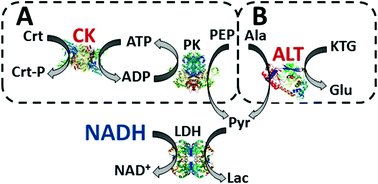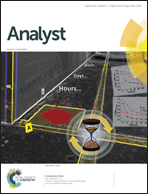Forensic determination of blood sample age using a bioaffinity-based assay†
Abstract
A bioaffinity-driven cascade assay was developed to determine the time elapsed from the point a blood sample was left at a crime scene to the point of discovery. Two blood markers, creatine kinase (CK) and alanine transaminase (ALT), were utilized to determine the age of the blood spot based on their natural denaturation processes. The analysis with the proposed bioassay was performed in human serum samples, which underwent the aging process under environmental conditions that could be expected at crime scenes. The concentration of the markers in the sample was based on physiological levels present in healthy adults. These two markers were concerted in a biocatalytic cascade composed of two parallel subsystems, with each of them following the activity of one marker. Both markers have very distinct denaturation rates which would not allow them to be used in a single marker setup while still providing satisfactory results. However, by parallel tunable monitoring of both markers, it is possible to provide information of the blood sample age with low temporal error for a prolonged period of time. To mimic a possible real crime scene situation – the reliability of the proposed assay was then successfully tested on dried/aged serum samples (up to 5 days old) in environments with different temperatures.


 Please wait while we load your content...
Please wait while we load your content...